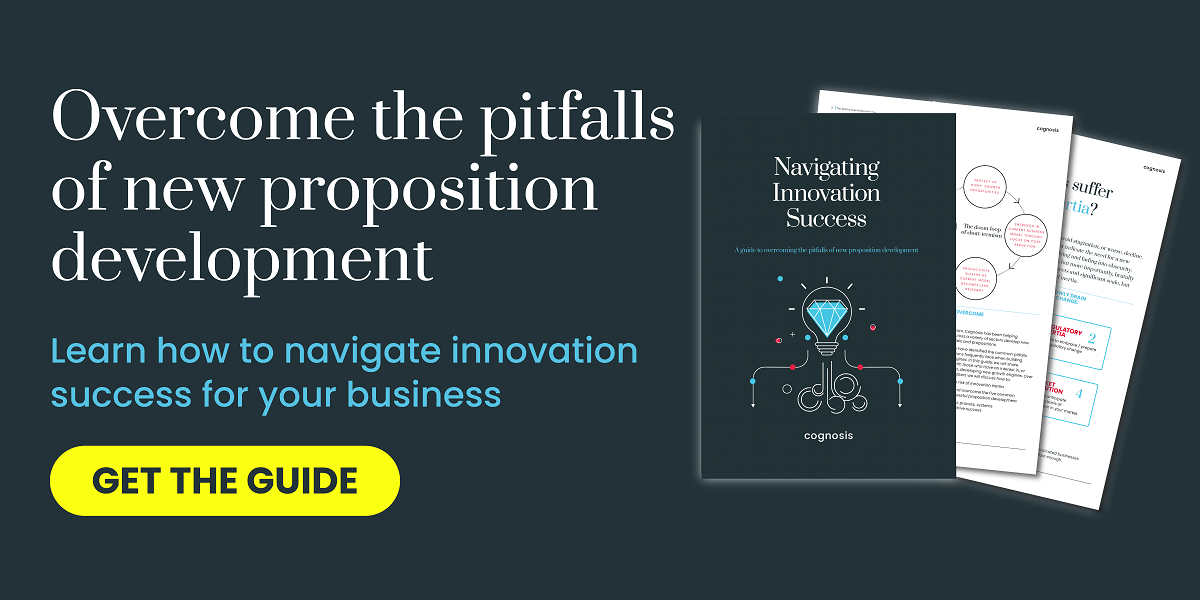Business Model Innovation - The case for value proposition development
Value proposition development (when done right) is an enabler for businesses to evolve their offering in a fast-changing environment. Businesses that achieve sustainable growth are those that reach beyond their current business models; embracing the changing needs of their customers with more speed and precision than the competition.

Faced with unprecedented volatility, companies must keep driving business model innovation. Value proposition development (when done right) is an enabler for businesses to evolve their offering and unlock success in a fast-changing environment.
Long-term growth is the aim of every CEO, but it’s only a few that see their ambitions come to fruition. As few as one in nine companies sustains profitable growth for a decade or more. Today’s volatile marketplace – with its concerns around digitisation and the impact of AI, inflation, compliance and talent acquisition – is a tough environment to be the exception.
Between a rock and a hard place
In a climate of rapid change, a growth mindset is a non-negotiable for survival. Businesses need to accelerate to keep up. Without new growth business models, there’s nowhere to go if current value propositions run out of road.
Of course, business model innovation requires more than generating novel ideas. New concepts must be ‘torture tested’ for ‘stickiness’. Will they have traction in the market and fuel growth by meeting the real needs of your customers?
Our research into the growth patterns of UK businesses within the mid-market revealed that ‘misfires’ – when new acquisitions or innovations underperform growth expectations – are a leading cause of growth decline or stagnation. We found that only 5% of companies avoid growth plateaus on the path to £1bn in revenue. These ‘high flyers’ consistently demonstrate the ability to look forward and drive change, investing in and developing new growth models alongside the core business.
> READ THE RESEARCH: Beyond the Horizon - A manifesto for long-term growth
Keeping one step ahead
Businesses that achieve sustainable growth are those that reach beyond the current business model and respond to a changing environment with more speed and precision than the competition. They’re not just responsive to customer needs, but proactively anticipating and setting out to satisfy future needs.
The most successful businesses are actively anticipating future customer needs and have a wide assortment of new growth models in incubation, as they know that several will crack along the way – including some of those that look the strongest. Leaders recognise the importance of developing fresh propositions and seek out opportunities to diversify their product or services portfolio. For example, we recently worked with the world’s largest brewer AB InBev on a value proposition called BEES that turned their beer distribution network into a B2B ecommerce platform.
On this ‘digital hive’, remote bars, shops and hotels across the globe can now order products online like snacks, detergents or batteries that arrive with the regular shipment of bottles or casks. Small businesses benefit by extending their range of goods. BEES shows how a traditional business can leverage their strengths and innovate by building a new proposition for their customers.
The now, the next and the new
What’s the formula for successfully bringing these new growth business models to market? We believe it requires the right mindset – the WHY – and then a rigorous approach – the HOW.
Regarding the WHY, our research found a clear pattern among visionary companies that disproportionally invest resource and money in business model innovations, services and offers. They actively resist the systemic pressures of short-termism. And it works too. A long-term orientation and appetite for change were shown to result in significant growth over a 15-year period.
For the HOW, it pays to give structure to creativity. Successful proposition development requires great insight, for sure, but it’s what happens next that makes it a winner:
- Aligning on a proposition canvas - a robust framework that helps to ensure a new product or service is positioned around what the customer truly values and needs
- Applying good commercial assumptions
- Pressure testing as a group and refining in line with consumer and customer research - both qualitative and quantitative
- Setting clear go/no-go gateways to avoid personal bias
- Building detailed go-to-market plans
Don't be disheartened!
Companies can lose confidence if new concepts fall short of expectation. Such misfires cause them to step back from the furnace of innovation and re-focus on their core business. But without that fresh impetus, they can soon enter a downward spiral of cost cutting and efficiencies, and the opportunity to branch out is lost.
The rewards of business model innovation and new growth engines are long-standing, while there is a tried-and-tested approach to making value propositions stick.
> RELATED ARTICLE: How to scale a business beyond a growth plateau


